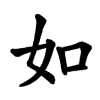Definify.com
Definition 2025
也
也
| ||||||
|---|---|---|---|---|---|---|
Translingual
| Stroke order | |||
|---|---|---|---|

| |||
| Stroke order | |||
|---|---|---|---|

| |||
Han character
也 (radical 5 乙+2, 3 strokes, cangjie input 心木 (PD), four-corner 44712, composition ⿻乜丨)
Descendants
References
- KangXi: page 84, character 4
- Dai Kanwa Jiten: character 171
- Dae Jaweon: page 170, character 4
- Hanyu Da Zidian: volume 1, page 50, character 5
- Unihan data for U+4E5F
Chinese
|
simp. and trad. |
也 | |
|---|---|---|
| alt. forms |
𠃟 𦫴 𦬀 𠔄 𠃒 |
|
Glyph origin
| Historical forms of the character 也
| ||||||||||||||||
|---|---|---|---|---|---|---|---|---|---|---|---|---|---|---|---|---|
| Bronze inscriptions | Bamboo and silk script | Large seal script | Small seal script | |||||||||||||
 |
 |
 |
 |
|||||||||||||
| ||||||||||||||||
|
References:
Mostly from Richard Sears' Chinese Etymology site (authorisation),
| ||||||||||||||||
| Characters in the same phonetic series (也) (Zhengzhang, 2003) | |
|---|---|
| Old Chinese | |
| 他 | *l̥ʰaːl |
| 拖 | *l̥ʰaːl, *l̥ʰaːls |
| 駞 | *l'aːl |
| 池 | *l'aːl, *l'al |
| 灺 | *ljalʔ |
| 鍦 | *ɦljaːl, *hljal, *hljals |
| 虵 | *ɦljal, *laːlʔ, *lal |
| 也 | *laːlʔ |
| 忚 | *hleːl |
| 髢 | *l'eːls |
| 杝 | *l̥ʰalʔ, *l'alʔ, *lal |
| 肔 | *l̥ʰalʔ, *lalʔ |
| 馳 | *l'al |
| 阤 | *l'alʔ, *hljalʔ |
| 施 | *hljal, *hljals |
| 絁 | *hljal |
| 葹 | *hljal |
| 弛 | *hljalʔ |
| 箷 | *lal |
| 衪 | *lel, *lalʔ |
| 暆 | *lel |
| 迆 | *lal, *lalʔ |
| 酏 | *lal, *lalʔ |
| 匜 | *lal, *lalʔ |
| 迤 | *lalʔ |
| 扡 | *lalʔ |
| 崺 | *lalʔ |
| 貤 | *lals, *ɦljels, *lels |
| 地 | *l'els |
Uncertain. There are various possible explanations:
- The traditional glyph origin given in Shuowen explains the character to be a pictograph of female genitalia.
- It is possibly a pictograph of an ancient funnel or wash basin. It may be an early form of 匜.
- It was once interchangeable with 它 and may have originated as a simplification.
- It may have been created to represent the modal particle (語氣詞/语气词 (yǔqìcí)). In some bronze inscriptions, it appears to be a mouth (口) with a curved line descending from it to represent air coming out of the mouth.
Pronunciation
- Mandarin
- Cantonese (Jyutping): jaa5
- Hakka (Sixian, PFS): ya
- Min Dong (BUC): iâ
- Min Nan (POJ): iǎ / iā / ǎ / ā
- Wu (Wiktionary): hha (T3); hhia (T3)
- Mandarin
- (Standard Chinese, Beijing)+
- Pinyin:
- Zhuyin: ㄧㄝˇ
- Wade-Giles: yeh3
- Gwoyeu Romatzyh: yiee
- IPA (key): /i̯ɛ²¹⁴/
-

- (Standard Chinese, Beijing)+
- Cantonese
- (Standard Cantonese, Guangzhou)+
- Jyutping: jaa5
- Yale: yáh
- Cantonese Pinyin: jaa5
- IPA (key): /jɑː¹³/
- (Standard Cantonese, Guangzhou)+
- Hakka
- (Northern Sixian, incl. Miaoli)
- Pha̍k-fa-sṳ: ya
- Hakka Romanization System: ia
- Hagfa Pinyim: ya4
- IPA: /i̯a⁵⁵/
- (Southern Sixian, incl. Meinong)
- Pha̍k-fa-sṳ: ya
- Hakka Romanization System: (r)ia
- Hagfa Pinyim: ya4
- IPA: /(j)i̯a⁵⁵/
- (Northern Sixian, incl. Miaoli)
- Min Dong
- (Fuzhou)
- Bàng-uâ-cê: iâ
- IPA (key): /iɑ²⁴²/
- (Fuzhou)
- Min Nan
- (Hokkien: Quanzhou)
- Pe̍h-ōe-jī: iǎ
- Tâi-lô: iǎ
- IPA (Quanzhou): /ia²²/
- (Hokkien: mainstream Taiwanese, Xiamen, Zhangzhou)
- Pe̍h-ōe-jī: iā
- Tâi-lô: iā
- Phofsit Daibuun: ia
- IPA (Taipei): /ia³³/
- IPA (Kaohsiung): /ia³³/
- IPA (Xiamen): /ia²²/
- IPA (Zhangzhou): /ia²²/
- (Hokkien: Quanzhou)
- Pe̍h-ōe-jī: ǎ
- Tâi-lô: ǎ
- IPA (Quanzhou): /a²²/
- (Hokkien: mainstream Taiwanese, Xiamen, Zhangzhou)
- Pe̍h-ōe-jī: ā
- Tâi-lô: ā
- Phofsit Daibuun: a
- IPA (Taipei): /a³³/
- IPA (Kaohsiung): /a³³/
- IPA (Xiamen): /a²²/
- IPA (Zhangzhou): /a²²/
- (Hokkien: Quanzhou)
- Wu
- (Shanghainese)
- Wiktionary: hha (T3); hhia (T3)
- IPA (key): /ɦᴀ²³/, /ɦiᴀ²³/
- (Shanghainese)
| Rime | |
|---|---|
| Character | 也 |
| Reading # | 1/1 |
| Initial (聲) | 以 (36) |
| Final (韻) | 麻 (100) |
| Tone (調) | Rising (X) |
| Openness (開合) | Open |
| Division (等) | III |
| Fanqie | 羊者切 |
| Reconstructions | |
| Zhengzhang Shangfang |
/jiaX/ |
| Pan Wuyun |
/jiaX/ |
| Shao Rongfen |
/iaX/ |
| Edwin Pulleyblank |
/jiaX/ |
| Li Rong |
/iaX/ |
| Wang Li |
/jĭaX/ |
| Bernard Karlgren |
/i̯aX/ |
| Expected Mandarin Reflex |
yě |
| Baxter-Sagart system 1.1 (2014) | |
|---|---|
| Character | 也 |
| Reading # | 1/1 |
| Modern Beijing (Pinyin) |
yě |
| Middle Chinese |
‹ yæX › |
| Old Chinese |
/*lAjʔ/ |
| English | (final particle) |
Notes for Old Chinese notations in the Baxter-Sagart system: * Parentheses "()" indicate uncertain presence; | |
| Zhengzhang system (2003) | |
|---|---|
| Character | 也 |
| Reading # | 1/1 |
| No. | 14773 |
| Phonetic component |
也 |
| Rime group |
歌 |
| Rime subdivision |
1 |
| Corresponding MC rime |
野 |
| Old Chinese |
/*laːlʔ/ |
Definitions
也
- also; too; as well
- (in negative sentences) neither, either
- Used for emphasis with object fronting. even
- Used for emphasis.
- (classical) An emphatic final particle of strong affirmation or identity.
- 生而知之者,上也 [Classical Chinese] ― shēng ér zhī zhī zhě, shàng yě [Pinyin] ― Those who are born with the possession of knowledge are the highest class of men.
-
- 其西有大山,天下至高者也。 [Classical Chinese, trad. and simp.]
- Qí xī yǒu dà shān, tiānxià zhì gāo zhě yě. [Pinyin]
- Laden with surrounding mountains, it is clearly the most supreme under heaven.
- A surname. Ye
Synonyms
| Dialectal synonyms of 也 (“also, too”) | ||
|---|---|---|
| Variety | Location | Words |
| Classical Chinese | 亦 | |
| Formal (Written Standard Chinese) | 也 | |
| Mandarin | Beijing | 也 |
| Taiwan | 也 | |
| Jinan | 也 | |
| Xi'an | 也 | |
| Wuhan | 也 | |
| Chengdu | 也 | |
| Yangzhou | 也 | |
| Hefei | 也 | |
| Cantonese | Guangzhou | 都、亦 |
| Hong Kong | 都、亦 | |
| Taishan | 亦 | |
| Yangjiang | 也 | |
| Gan | Nanchang | 也 |
| Hakka | Meixian | 也 |
| Miaoli (N. Sixian) | 乜 | |
| Liudui (S. Sixian) | 乜、也 | |
| Hsinchu (Hailu) | 乜 | |
| Dongshi (Dabu) | 乜 | |
| Zhuolan (Raoping) | 乜 | |
| Yunlin (Zhao'an) | 嘛 | |
| Jin | Taiyuan | 也 |
| Min Bei | Jian'ou | 也 |
| Min Dong | Fuzhou | 也 |
| Min Nan | Quanzhou | 也、嘛 |
| Xiamen | 也、嘛 | |
| Zhangzhou | 也、嘛 | |
| Taipei | 也、嘛 | |
| Chaozhou | 也 | |
| Wu | Suzhou | 也 |
| Wenzhou | 也 | |
| Xiang | Changsha | 也 |
| Shuangfeng | 也 | |
Compounds
|
Korean
Hanja
也 • (ya)
Eumhun:
- Sound (hangeul): 야 (revised: ya, McCune-Reischauer: ya)
- Name (hangeul): 이끼, 어조사 (revised: ikki, eojosa, McCune-Reischauer: ikki, ǒjosa)
- This term needs a translation to English. Please help out and add a translation, then remove the text
{{rfdef}}.
References
Vietnamese
Han character
- This term needs a translation to English. Please help out and add a translation, then remove the text
{{rfdef}}.












